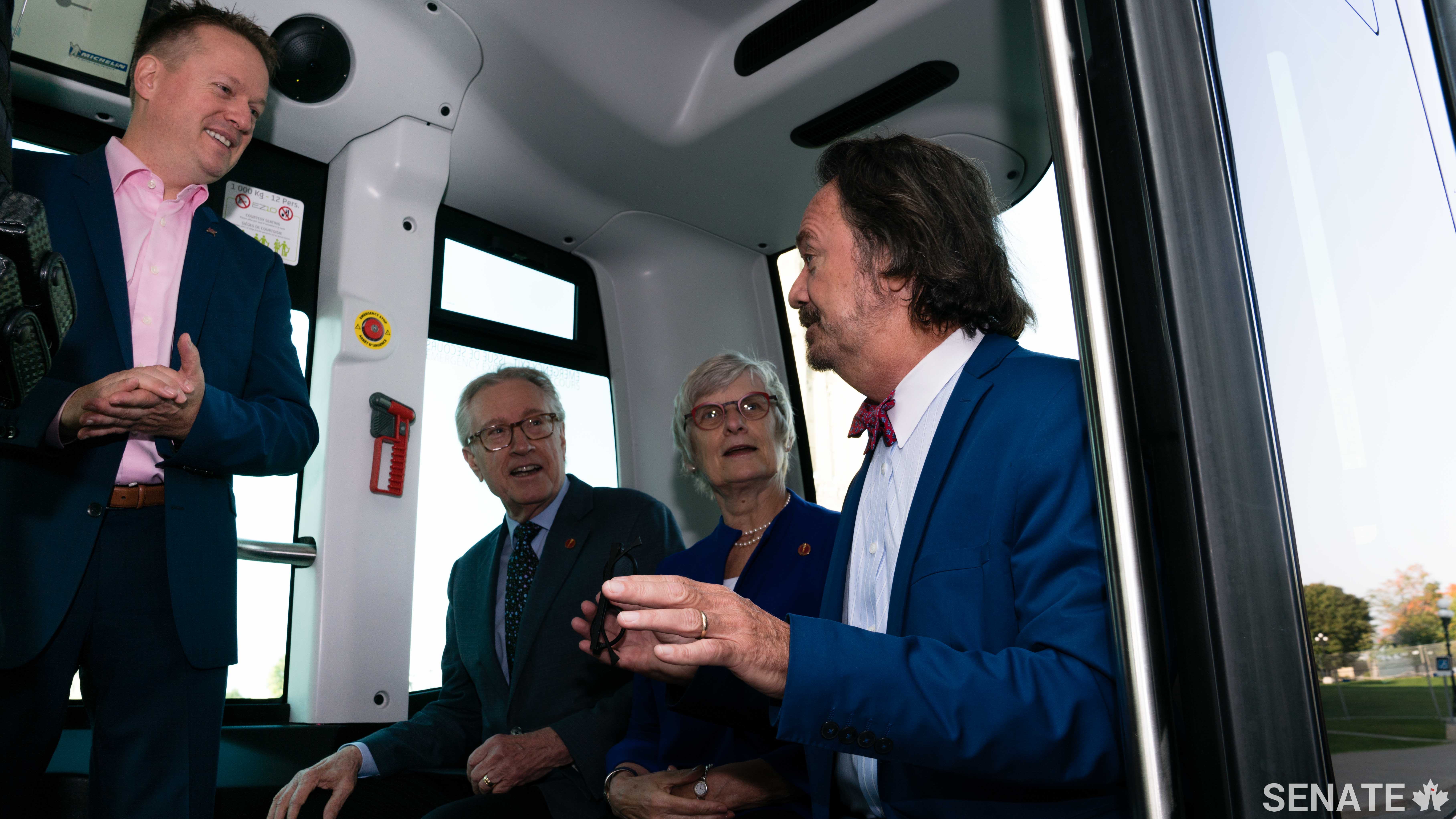Government must keep pace with autonomous vehicle developments: Senator Dawson

Tags

The next revolution in transportation is around the corner and unless Canada accelerates, other jurisdictions will zoom by in the fast lane.
Autonomous vehicles are ready to hit our roads and streets. To demonstrate the pressing need for action, last week senators swapped their parliamentary shuttle bus for a few laps around Parliament Hill in a driverless, steering-wheel-free bus. Rolling at a reduced speed of ten kilometres per hour (the model can currently reach 30 kilometres per hour), the shiny red machine rang its very real bell at curious journalists as they jumped around and in front of it to test the machine’s reflexes.
This has come after hearings held by the Senate Committee on Transport and Communications, as part of its ongoing study on the new technology.
The study came about because a number of innovations in recent years have brought the technology of autonomous driving much closer to being market-ready. These include heightened computer vision and mapping, as well as the explosion of ride-sharing algorithms and applications. Better security measures, such as adaptive cruise control, lane-departure warnings and head-on collision avoidance have also put driverless vehicles on the fast track. All of these technologies are already being used by consumers across Canada — they aren’t just “high end” anymore. They are becoming ever cheaper and increasingly accessible to all consumers.
Since the first factories opened and the first rail lines were laid two centuries ago, humans have been coping with wave after wave of innovation, reacting from excited to fearful to hostile. There’s no doubt that autonomous vehicles will bring with them another transformation.
How can we expect society to change as a result of this ground-breaking technology?
For one, driving is about to become the safest way to travel. In 2015, more than 1,800 people died in Canada as a result of motor vehicle accidents. That same number is over a million worldwide. Furthermore, more than 160,000 injuries were the result of motor vehicle accidents in Canada.

Autonomous vehicles will certainly help address those dire statistics.
Furthermore, with accessible, ridesharing, driverless cars, the number of vehicles needed to satisfy society’s transportation needs will drop tremendously — some experts say by as much as 95%. That means less congestion, considerably shorter commute times, freed-up space previously used by parked cars and a sharp drop in transport-related carbon emissions, accentuated by the fact that most of these cars are battery-powered.
This is technology for everyone. We’re talking about cars, buses and trucks. We’re talking about urban and rural transportation. This would make suburban life cheaper, as well as making mobility costs for people living with disabilities fairer.
But the picture isn’t just a rosy one.
We’re looking at the potential collapse of the automobile manufacturing industry, a sector that employs more than 100,000 Canadians. Almost 300,000 Canadians are employed as drivers from truckers to delivery-service drivers, from taxi drivers to bus operators. Most of these individuals often do not have transferable skills.
Other industries will see changes as well, including auto-insurance, auto-repair, parking, law, energy — the list goes on.
The concerns extend to the realms of privacy and cyberattacks as well. Big data analysis could make travel more efficient, but if these systems were to be hacked, or if insufficient privacy measures leads to unethical use of this information, people’s rights will be infringed upon, or worse, could be put in danger.
In short, our policies must keep up with the technology.
We need to start building a regulatory framework across levels of government, just as we need to start issuing more pilot program licenses to stay on top of it all.
Autonomous vehicles are coming, one way or another, and with them will come inevitable changes. The real question is — how can we get ready?
Senator Dennis Dawson represents Lauzon, Quebec. He is chair of the Senate Standing Committee on Transport and Communications
This article appeared in the September 27, 2017 edition of the Montreal Gazette.
Note to readers: The Honourable Dennis Dawson retired from the Senate of Canada in February 2023. Learn more about his work in Parliament.

The next revolution in transportation is around the corner and unless Canada accelerates, other jurisdictions will zoom by in the fast lane.
Autonomous vehicles are ready to hit our roads and streets. To demonstrate the pressing need for action, last week senators swapped their parliamentary shuttle bus for a few laps around Parliament Hill in a driverless, steering-wheel-free bus. Rolling at a reduced speed of ten kilometres per hour (the model can currently reach 30 kilometres per hour), the shiny red machine rang its very real bell at curious journalists as they jumped around and in front of it to test the machine’s reflexes.
This has come after hearings held by the Senate Committee on Transport and Communications, as part of its ongoing study on the new technology.
The study came about because a number of innovations in recent years have brought the technology of autonomous driving much closer to being market-ready. These include heightened computer vision and mapping, as well as the explosion of ride-sharing algorithms and applications. Better security measures, such as adaptive cruise control, lane-departure warnings and head-on collision avoidance have also put driverless vehicles on the fast track. All of these technologies are already being used by consumers across Canada — they aren’t just “high end” anymore. They are becoming ever cheaper and increasingly accessible to all consumers.
Since the first factories opened and the first rail lines were laid two centuries ago, humans have been coping with wave after wave of innovation, reacting from excited to fearful to hostile. There’s no doubt that autonomous vehicles will bring with them another transformation.
How can we expect society to change as a result of this ground-breaking technology?
For one, driving is about to become the safest way to travel. In 2015, more than 1,800 people died in Canada as a result of motor vehicle accidents. That same number is over a million worldwide. Furthermore, more than 160,000 injuries were the result of motor vehicle accidents in Canada.

Autonomous vehicles will certainly help address those dire statistics.
Furthermore, with accessible, ridesharing, driverless cars, the number of vehicles needed to satisfy society’s transportation needs will drop tremendously — some experts say by as much as 95%. That means less congestion, considerably shorter commute times, freed-up space previously used by parked cars and a sharp drop in transport-related carbon emissions, accentuated by the fact that most of these cars are battery-powered.
This is technology for everyone. We’re talking about cars, buses and trucks. We’re talking about urban and rural transportation. This would make suburban life cheaper, as well as making mobility costs for people living with disabilities fairer.
But the picture isn’t just a rosy one.
We’re looking at the potential collapse of the automobile manufacturing industry, a sector that employs more than 100,000 Canadians. Almost 300,000 Canadians are employed as drivers from truckers to delivery-service drivers, from taxi drivers to bus operators. Most of these individuals often do not have transferable skills.
Other industries will see changes as well, including auto-insurance, auto-repair, parking, law, energy — the list goes on.
The concerns extend to the realms of privacy and cyberattacks as well. Big data analysis could make travel more efficient, but if these systems were to be hacked, or if insufficient privacy measures leads to unethical use of this information, people’s rights will be infringed upon, or worse, could be put in danger.
In short, our policies must keep up with the technology.
We need to start building a regulatory framework across levels of government, just as we need to start issuing more pilot program licenses to stay on top of it all.
Autonomous vehicles are coming, one way or another, and with them will come inevitable changes. The real question is — how can we get ready?
Senator Dennis Dawson represents Lauzon, Quebec. He is chair of the Senate Standing Committee on Transport and Communications
This article appeared in the September 27, 2017 edition of the Montreal Gazette.
Note to readers: The Honourable Dennis Dawson retired from the Senate of Canada in February 2023. Learn more about his work in Parliament.


